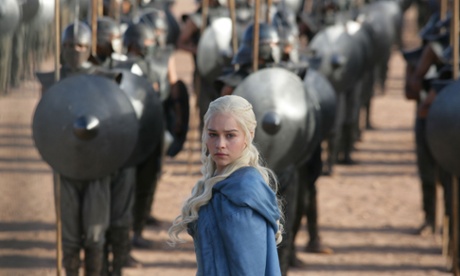
If, like me, you haven’t had the chance to catch up with John Gwynne’s ongoing four-book series The Faithful and the Fallen, then you might have greeted the news he’s landed a “six-figure deal” for another three novels with a shrug. But the arrival of yet another writer “in the tradition of George RR Martin and David Gemmell” has set me thinking about how the fantasy genre found itself overrun by multi-volume novels.
Money talks, of course, and ever since Tolkien laid down the basic three-part formula, his vision has gradually expanded into the multi-volume moneyspinners of today. If every reader has to buy 15 separate volumes of Robert Jordan’s Wheel of Time at £8.99 a pop, that adds up to a 44m-copy pay day for his publishers. But this commercial appeal is clogging up the genre with tome after tome of schlock, as anyone who has had the misfortune of being trapped in a confined space with only a Terry Goodkind novel for entertainment can confirm.
Series novels are common in many genres of fiction, none more so than crime, mysteries and thrillers. The formula of a lone detective investigating a new murder in each book has changed little in the decades between Agatha Christie and Lee Child. Serials, which tell one ongoing story with the same cast of characters that continues through each volume, are considerably rarer. But it’s exactly this serial format that has come to dominate the fantasy genre.
Fantasy novels have grown so vast that even the serial concept no longer quite captures what they are doing. In a recent essay, the sci-fi novelist Eric Flint suggested the term “mega-novel” to better express what fantasy serials of this kind are doing. While they may be broken into separate volumes for commercial reasons, these are really just very big novels, often with multiple heroes, each surrounded by their own cast of supporting characters. They’re not just big and long, but structurally complex in a way that requires that extra space.
The mega-novel is by no means new. War and Peace and Les Misérables were the mega-novels of their day, exploiting the novel’s almost infinite space to tell stories that swept from the drawing room to the battlefield, from high society to the gutter. The real world is massive and chaotic beyond the scope of any story, but the novel has always been the storytelling medium that could come closest to capturing it. And the novels that dared to really try – from Hugo to Tolstoy – are often the ones that have endured.
The reigning contemporary master of the mega-novel is George RR Martin, of course, whose books now sell in such vast quantities they could be used to build a mile-high wall across the north in real life. I’ve already written on the qualities of Game of Thrones, from the way it revitalises the common archetypes of fantasy fiction to its Shakespearean skewering of powerful elites. But it’s also a staggering technical achievement as a work of fiction, which very few writers could pull off.
GRRM was in his 40s when he began A Game of Thrones, with a substantial writing career already behind him. He won his first Hugo in his 20s, published a bunch of bestselling novels in his 30s and then spent a decade or so honing his storytelling skills in Hollywood development hell. That’s the kind of experience a writer needs to tackle a project like A Game of Thrones – native talent isn’t enough. But when publishers went looking for the next GRRM, they somehow forgot these vital steps.
A deluge of multi-volume epics has been published over recent years, each one in turn hailed as the next Game of Thrones, only to disappear within a few months as disappointed readers found reality didn’t match the hype. Some were by excellent writers who don’t quite have the breadth to tackle a full mega-novel, telling stories that would have been better told in a single volume. Most were by debut novelists, often interesting writers with some good short stories under their belt, pushed far beyond their technical abilities by an industry hungry for instant commercial success.
The mega-novel is a pinnacle of the storyteller’s craft. When a writer appears who can really create one, it will aways be a major event. Gwynne’s six-figure deal is a sign publishers are ready to invest in big stories, but there’s more to reading than bingeing on epics. If the fantasy genre, and fiction more widely, wants to remain healthy, it needs to nurture all kinds of stories. There are great fantasy short stories, novellas and single novels that deserve much wider audiences, but are sidelined by the industry’s unhealthy fixation with the serial format. It’s time for the fantasy genre to tell some new – shorter – stories.

